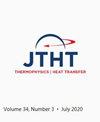Modeling of Uncertainty Propagation for Transient Heat Rejection Problems
IF 1.7
4区 工程技术
Q4 ENGINEERING, MECHANICAL
引用次数: 0
Abstract
Generic plate and experiment-related high-fidelity models to study uncertainty propagation and transient processes for heat rejection problems are developed. The stochastic Biot numbers on the top and bottom surfaces of the plate, [Formula: see text] and [Formula: see text], and stochastic dimensionless input parameters, describing initial and convection boundary conditions, are introduced to define temperature variation in the modeled systems. The resulting uncertainty amplitude demonstrates a varying time evolution across a wide range of mean values of the input parameters. Depending on which input parameters are stochastic, the uncertainty may increase or decrease over time, or remain small for a given time interval in the case of the plate model. For small [Formula: see text], dimensionless characteristic time for a temperature variation curve to approach its steady state is [Formula: see text] and large. An extremum in a temperature variation curve may appear when the Biot numbers are unequal and disappears if [Formula: see text]. Results are nonsymmetric with respect to interchanging [Formula: see text] and [Formula: see text]. Despite the difference in shape, the temperature variation profile over a specific region in the experimental test section numerically described by the high-fidelity model is close to the corresponding results provided by the plate model for the same Biot numbers, convection boundary, and initial conditions.瞬态散热问题的不确定性传播建模
建立了通用的平板模型和实验相关的高保真模型,用于研究散热问题的不确定性传播和瞬态过程。引入板的上下表面的随机Biot数,[公式:见文]和[公式:见文],以及描述初始和对流边界条件的随机无量纲输入参数来定义模拟系统的温度变化。由此产生的不确定性振幅在输入参数的广泛平均值范围内表现出随时间变化的演化。根据哪些输入参数是随机的,不确定性可能随着时间的推移而增加或减少,或者在给定的时间间隔内保持较小。对于小[公式:见文],温度变化曲线趋于稳态的无量纲特征时间为[公式:见文],大。当Biot数不相等时,温度变化曲线上可能出现极值,如果[公式:见文],则极值消失。在交换[公式:见文本]和[公式:见文本]时,结果是不对称的。尽管形状不同,但在相同Biot数、对流边界和初始条件下,高保真模型数值描述的实验测试段内特定区域的温度变化曲线与平板模型给出的结果接近。
本文章由计算机程序翻译,如有差异,请以英文原文为准。
求助全文
约1分钟内获得全文
求助全文
来源期刊

Journal of Thermophysics and Heat Transfer
工程技术-工程:机械
CiteScore
3.50
自引率
19.00%
发文量
95
审稿时长
3 months
期刊介绍:
This Journal is devoted to the advancement of the science and technology of thermophysics and heat transfer through the dissemination of original research papers disclosing new technical knowledge and exploratory developments and applications based on new knowledge. The Journal publishes qualified papers that deal with the properties and mechanisms involved in thermal energy transfer and storage in gases, liquids, and solids or combinations thereof. These studies include aerothermodynamics; conductive, convective, radiative, and multiphase modes of heat transfer; micro- and nano-scale heat transfer; nonintrusive diagnostics; numerical and experimental techniques; plasma excitation and flow interactions; thermal systems; and thermophysical properties. Papers that review recent research developments in any of the prior topics are also solicited.
 求助内容:
求助内容: 应助结果提醒方式:
应助结果提醒方式:


